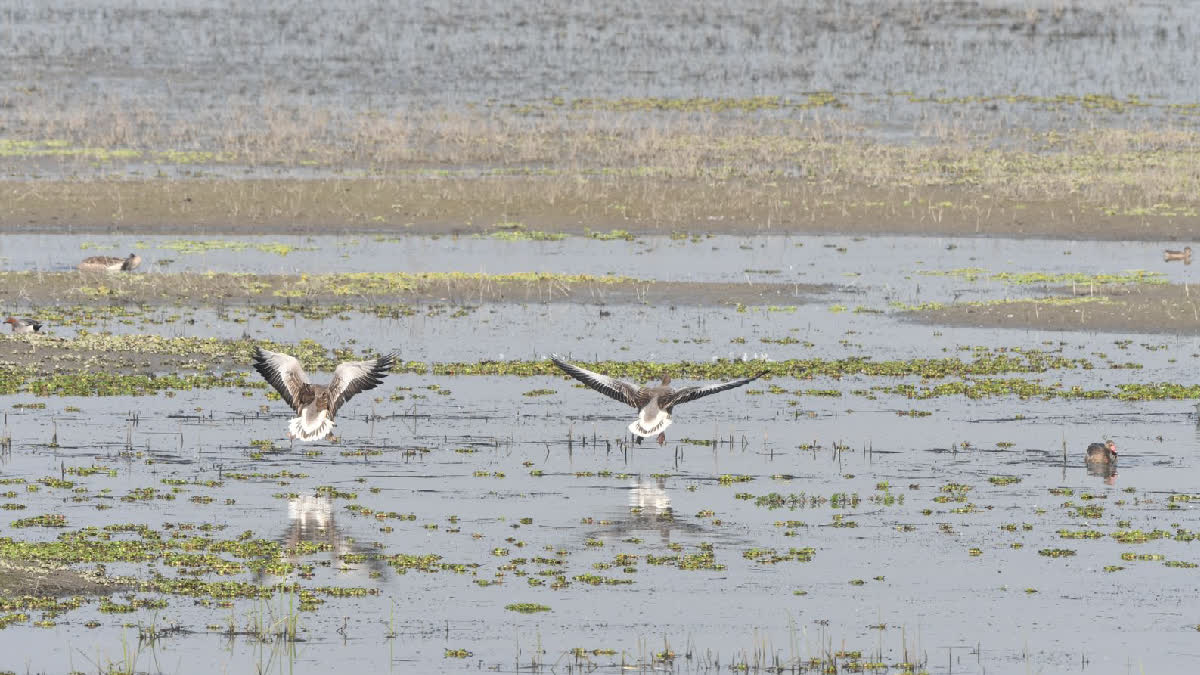Nagaon:It is raining good news for the Laokhowa Burhachapori Wildlife Sanctuary in Assam. After about 40 years, the wildlife sanctuary witnessed the movement of one-horned rhinos, and the wetlands are now in focus for drawing more water birds than Assam's only Ramsar site, the Deepor Beel.
While the Deepor Beel, which is the only listed Ramsar Site in Assam, has drawn about 17,623 birds this year, the wetlands in Laokhowa Burhachapori has been able to draw 54,961 water birds this year.
A two-day waterbird population estimation in the Kaziranga Tiger Reserve brought this startling fact to the fore which counted 124 species of water and wetland-dependent birds, totalling 1,12,062 individuals from 25 families across 189 beels. The estimation further recorded the highest number of species (107) and 54,961 individuals in the Nagaon Wildlife Division, which includes the Laokhowa Burhachapori Wildlife Sanctuary. The estimation also highlighted the Rowmari-Donduwa complex of Laokhowa Burhachapori Wildlife Sanctuary as a significant site for migratory birds and hence a potential Ramsar site.
"The water bird population estimation in the Kaziranga Tiger Reserve has already been completed. While the Nagaon Wildlife Division, Biswanath Wildlife Division and Kaziranga Wildlife Division which are under Kaziranga Tiger Reserve recorded over 112000 water birds this year. Out of these 112000 water birds, 54,961 water birds belonging to 107 species are found in the wetlands in Laokhowa Burhachapori wildlife sanctuary," said Rajib Hazarika Divisional Forest officer of Nagaon Wildlife division.
"This is good news for us and this certainly is going to shift the focus to Laokhowa Burhachapori Wildlife Sanctuary," he said while expressing his happiness.
Laokhowa Burhachapori Wildlife Sanctuary used to be a habitat for one-horned rhinos earlier but was wiped off its one-horned rhino population. However, the forest officials deployed at the Laokhowa Burhachapori Wildlife Sanctuary spotted two one-horned rhinos in the sanctuary in early 2023. The development assumed significance as it was after about 40 years that rhinos were spotted in the Laokhowa Burhachapori Wildlife Sanctuary. According to records of the forest department, there were about 40 to 50 one-horned rhinos in Laokhowa Burhachapori wildlife sanctuary till 1983. Although poaching was one of the main factors that led to the declining rhino population, the degradation of grassland habitat due to various anthropogenic reasons also reduced the number of the species and there had been no rhinos left in the wildlife sanctuary after that.
The positive development, however, took place in 2023 after the Assam government launched a massive eviction drive to clear encroachment, particularly from the forest lands.
"There are more than 20 wetlands under Laokhowa Burhachapori Wildlife Sanctuary. However, the wildlife sanctuary suffered in the last 40 years due to encroachment. However, after the Assam government took serious note of the encroachment in the wildlife sanctuary and carried out eviction drives, it led to positive effects. While wildlife like rhinos and elephants are gradually reclaiming their habitats in Laokowa Burhachapori, the eviction drives carried out in 2023 also helped the birds to arrive in the wetlands," said Hazarika.
"There used to be unrestricted fishing in the wetlands inside Laokhowa Burhachapori earlier, mostly by the encroachers. However, the eviction drives cleared the encroachment and it restored the ecology of the wetlands," said the officer.
"We are happy that the wetlands have been able to draw the water birds and other migratory birds. We appreciate the government action against the encroachment since 2023 which has led to positive developments," said Kulen Das, secretary of the Laokhowa Burhachapori Conservation Society (LBCS), a local community organisation which has been working for conservation of the wildlife for a long time.
It may be mentioned here that the forest department along with Assam police have cleared encroachment from 2099 hectares of land in 2022-23. The eviction drives conducted jointly by the forest department and Assam police have evicted over 12,765 people and demolished 2553 houses from the wildlife sanctuary.
